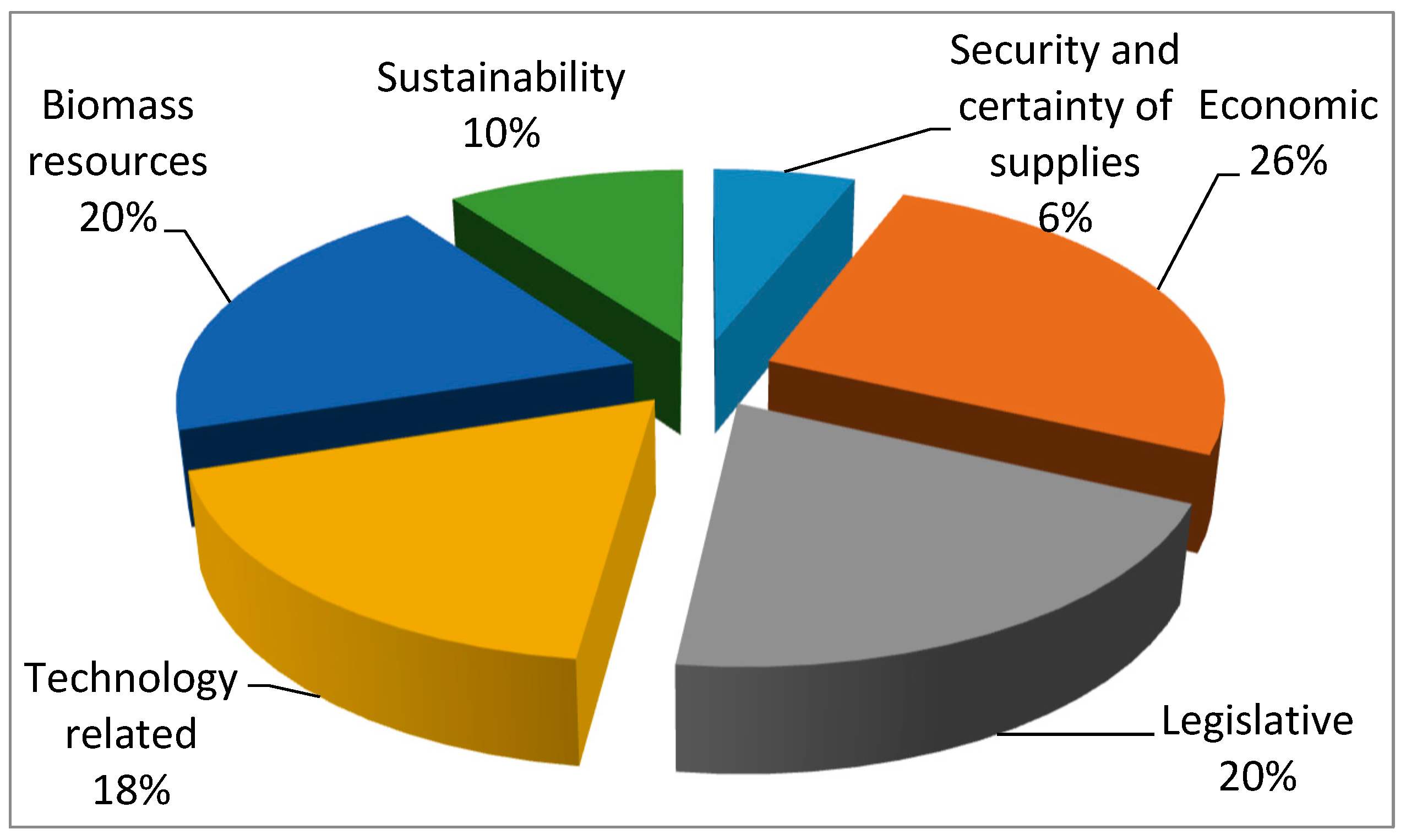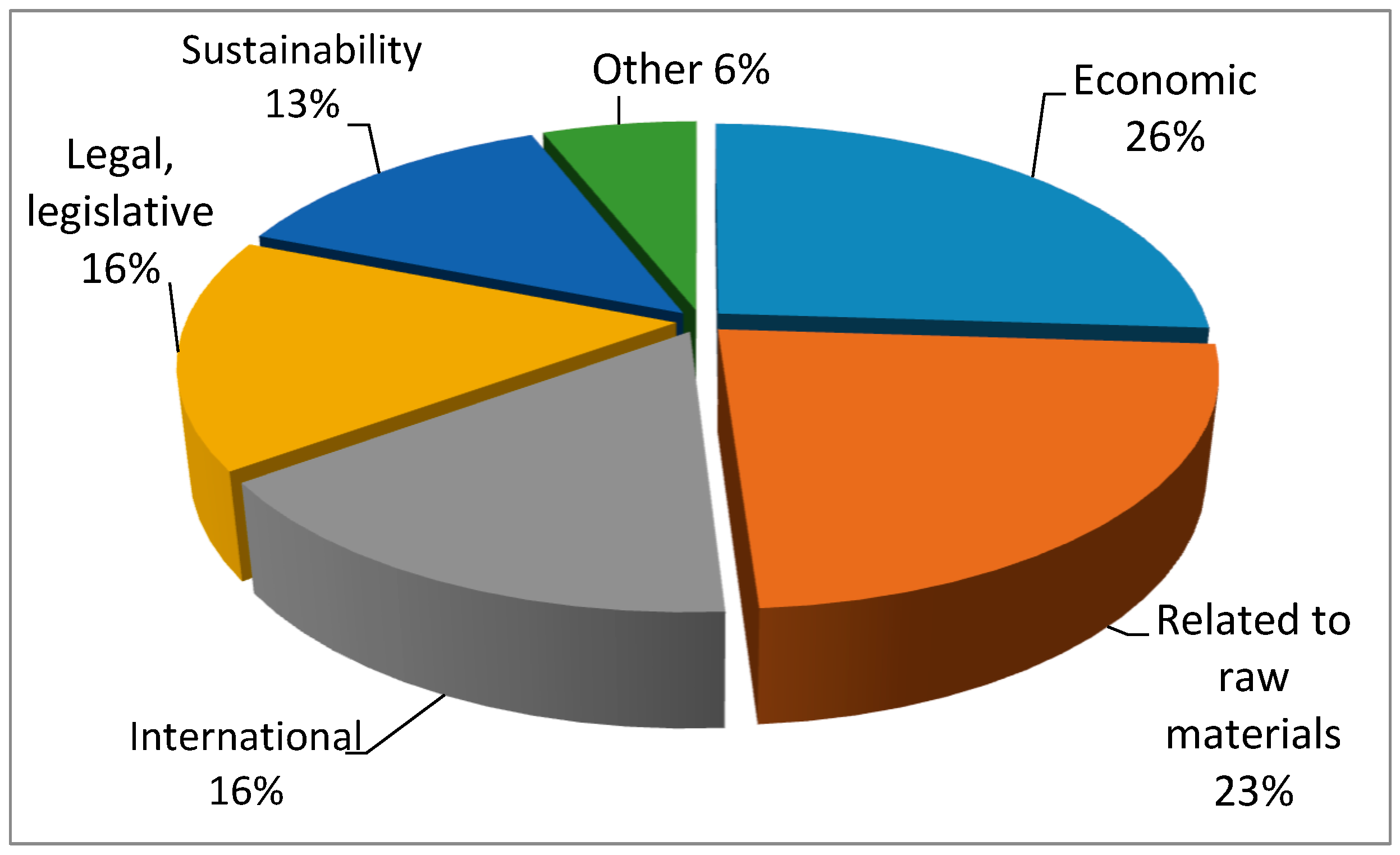Problems of Selected Sectors of Biofuels for Transport in Poland
Abstract
:1. Introduction
2. Methodology
3. Renewable Energies for Transport in EU and Poland: Actual Data and Regulatory Constraints—Contribution to Discussion
3.1. European Union’s Objectives on Renewable Energy in Transport
3.2. History, Current Status and Prospects for Transport Biofuels in Poland
3.3. Production and Usage
3.4. Poland as Compared with the European Union
3.5. Barriers in Accomplishment of Tasks Connected with Biofuels for Transport
- -
- in the case of biomass used for production of conventional biofuels, competitive towards food, barriers are usually due to low terminal reduction of the biocomponent
- -
- in the case of biomass used for production of advanced biocomponents, biomass is usually waste-based, but used by many markets competitively towards one another and, consequently, becoming difficult to access.
3.6. Other Problems of the Biofuels Sector in Poland
4. Conclusions
Author Contributions
Funding
Institutional Review Board Statement
Informed Consent Statement
Data Availability Statement
Conflicts of Interest
References
- Kruk, A. Definicje normatywne biopaliw ciekłych i biokomponentów oraz ich wzajemne zależności. Młody Jurysta Kwart. Stud. Dr. Wydziału Prawa Adm. UKSW 2019, 64–76. [Google Scholar] [CrossRef]
- Agarwal, A.K.; Gautam, A.; Sharma, N.; Singh, A.P. Introduction of Methanol and Alternate Fuel Economy. In Methanol and the Alternate Fuel Economy; Springer: Singapore, 2019; pp. 3–6. [Google Scholar]
- Stančin, H.; Mikulčić, H.; Wang, X.; Duić, N. A review on alternative fuels in future energy system. Renew. Sustain. Energy Rev. 2020, 128, 109927. [Google Scholar] [CrossRef]
- Pomykała, R. Biogaz paliwem dla transportu (Biogas as a fuel for transport). In Proceedings of the Akademia Górniczo-Hutnicza im. Stanisława Staszica w Krakowie—Forum Recyklingu, Poznań, Poland, 22–24 November 2011; Volume 11, p. 45. [Google Scholar]
- König, A.; Siska, M.; Schweidtmann, A.M.; Rittig, J.G.; Viell, J.; Mitsos, A.; Dahmen, M. Designing production-optimal alternative fuels fo r conventional, flexible-fuel, and ultra-high efficiency engines. Chem. Eng. Sci. 2021, 237, 116562. [Google Scholar] [CrossRef]
- Directive 2009/28/EC of the European Parliament and of the Council of 23 April 2009 on the Promotion of the Use of Energy From Renewable Sources and Amending and Subsequently Repealing Directives 2001/77/EC and 2003/30/EC. Available online: https://eur-lex.europa.eu/legal-content/EN/ALL/?uri=CELEX%3A32009L0028 (accessed on 15 May 2021).
- Directive (EU) 2018/2001 of the European Parliament and of the Council of 11 December 2018 on the Promotion of the Use of Energy from Renewable Sources. Available online: https://eur-lex.europa.eu/legal-content/EN/TXT/?uri=CELEX%3A32018L200 (accessed on 15 May 2021).
- Kupczyk, A.; Mączyńska-Sęczek, J.; Golisz, E.; Borowski, P.F. Renewable Energy Sources in Transport on the Example of Methyl Esters and Bioethanol. Processes 2020, 8, 1610. [Google Scholar] [CrossRef]
- Ustawa z Dnia 11 Stycznia 2018, r. O Elektromobilności i Paliwach Alternatywnych. (The Act of January 11, 2018 on Electromobity and Alternative Fuels). Dz.U. 2018 Poz. 317. Available online: https://isap.sejm.gov.pl/isap.nsf/DocDetails.xsp?id=WDU20180000317 (accessed on 15 May 2021).
- Directive 2014/94/EU of the European Parliament and of the Council of 22 October 2014 on the Deployment of Alternative Fuels Infrastructure Text with EEA Relevance. Available online: https://eur-lex.europa.eu/legal-content/EN/TXT/?uri=celex%3A32014L0094 (accessed on 15 May 2021).
- Krajowe Ramy Polityki Rozwoju Infrastruktury Paliw Alternatywnych. (National Policy Framework of the Development of Alternative Fuels Infrastructure). Warszawa, 29 Marca 2017. Available online: File:///C:/Users/User/Downloads/DRO_Krajowe_ramy_polityki_rozwoju_infrastruktury_paliw_alternatywnych.pdf (accessed on 15 May 2021).
- Burchart-Korol, D.; Gazda-Grzywacz, M.; Zarębska, K. Research and Prospects for the Development of Alternative Fuels in the Transport Sector in Poland: A Review. Energies 2020, 13, 2988. [Google Scholar] [CrossRef]
- Rimkus, A.; Stravinskas, S.; Matijošius, J. Comparative study on the energetic and ecologic parameters of dual fuels (diesel–NG and HVO–biogas) and conventional diesel fuel in a CI engine. Appl. Sci. 2020, 10, 359. [Google Scholar] [CrossRef] [Green Version]
- Golisz, E.; Kupczyk, A. Sektor biogazowni rolniczych w Polsce (The agricultural biogas plant sector in Poland). In Innowacyjne Technologie Pozyskania Energii Odnawialnej; Romaniuk, W., Ed.; Instytut Techologiczno-Przyrodniczy: Falenty, Poland, 2020; Volume XXVI. [Google Scholar]
- Wojdalski, J.; Grochowicz, J.; Ekielski, A.; Radecka, K.; Stępniak, S.; Orłowski, A.; Florczak, I.; Drozdz, B.; Zelazinski, T.; Kosmala, G. Production and properties of apple pomace pellets and their suitability for energy generation purposes. Rocz. Ochr. Srodowiska 2016, 18, 89–111. [Google Scholar]
- Borowski, P.F. Nexus between water, energy, food and climate change as challenges facing the modern global, European and Polish economy. AIMS Geosci. 2020, 6, 397–421. [Google Scholar] [CrossRef]
- Centobelli, P.; Cerchione, R.; Esposito, E.; Oropallo, E. Surfing blockchain wave, or drowning? Shaping the future of distributed ledgers and decentralized technologies. Technol. Forecast. Soc. Chang. 2021, 165, 120463. [Google Scholar] [CrossRef]
- Yin, R.K. Case Study Research and Applications: Design and Methods; SAGE Publications Inc: London, UK, 2018. [Google Scholar]
- Subramaniam, Y.; Masron, T.A.; Azman, N.H.N. Biofuels, environmental sustainability, and food security: A review of 51 countries. Energy Res. Soc. Sci. 2020, 68, 101549. [Google Scholar] [CrossRef]
- Directive (EU) 2015/1513 of the European Parliament and of the Council of 9 September 2015 Amending Directive 98/70/EC Relating to the Quality of Petrol and Diesel Fuels and Amending Directive 2009/28/EC on the Promotion of the Use of Energy from Renewable Sources. Available online: https://eur-lex.europa.eu/legal-content/EN/TXT/?uri=celex%3A32015L1513 (accessed on 15 May 2021).
- Kim, E.J.; Kim, S.; Choi, H.G.; Han, S.J. Co-production of biodiesel and bioethanol using psychrophilic microalga Chlamydomonas sp. KNM0029C isolated from Arctic sea ice. Biotechnol. Biofuels 2020, 13, 1–13. [Google Scholar] [CrossRef]
- Giuntoli, J. Advanced Biofuel Policies in Select UE Member States: 2018 Update. International Council on Clean Transportation. 2018. Available online: https://theicct.org/sites/default/files/publications/Advanced_biofuel_policy_eu_update_20181130.pdf (accessed on 6 November 2019).
- Wróbel, P.; Ścigan, M. Cel OZE na 2020: Co Się Stanie, Jeśli Polska Go Nie Osiągnie? 2020. Available online: www.cire.pl/item,195211,13,0,0,0,0,0,cel-oze-na-2020-co-sie-stanie-jesli-polska-go-nie-osiagnie.html (accessed on 12 January 2021).
- Bórawski, P.; Bełdycka-Bórawska, A.; Szymańska, E.J.; Jankowski, K.J.; Dubis, B.; Dunn, J.W. Development of renewable energy sources market and biofuels in The European Union. J. Clean. 2019, 228, 467–484. [Google Scholar] [CrossRef]
- Piechota, G.; Igliński, B. Biomethane in Poland—Current Status, Potential, Perspective and Development. Energies 2021, 14, 1517. [Google Scholar] [CrossRef]
- EurObserv’ER. Biofuels Barometer. 2020. Available online: https://www.eurobserv-er.org/biofuels-barometer-2020/ (accessed on 15 May 2021).
- Kupczyk, A.; Borowski, P.; Powałka, M.; Ruciński, D. Transport Biofuels in Poland. Current Status and Prospects (Biopaliwa transportowe w Polsce. Stan Aktualny I Perspektywy); WEMA Wydawnictwo Poligraficzne: Warszawa, Poland, 2011. [Google Scholar]
- Golisz, E.; Kupczyk, A.; Borowski, P.; Szwarc, M. Problemy z redukcją emisji CO2 biopaliw transportowych w Polsce. Cz. 1. Uwarunkowania prawne a atrakcyjność sektora biopaliw transportowych. (Problems with the emissions reduction of CO2 transport biofuels in Poland, part 1). PFiOW 2014, 58, 16–17. [Google Scholar]
- Golisz, E.; Gawron, J.; Żak, A.; Kupczyk, A. Problemy z redukcją emisji CO2 biopaliw transportowych w Polsce. Cz. 2. Przyszłość sektora biopaliw transportowych. (Problems with the emissions reduction of CO2 transport biofuels in Poland, part 2). PFiOW 2014, 58, 37–39. [Google Scholar]
- Golisz, E.; Borowski, P.; Sikora, M. Problemy z redukcją emisji CO2 biopaliw transportowych w Polsce. Cz. 3. Badania redukcji emisji CO2. (Problems with the emissions reduction of CO2 transport biofuels in Poland, part 3). PFiOW 2014, 58, 52–54. [Google Scholar]
- Golisz, E.; Wójcik, G. Problemy gorzelni rolniczych i przemysłu bioetanolowego w Polsce. (Problems of Agricultural Distilleries and the Bioethanol Industry in Poland). Inżyniera Rolnicza 2013, 2, 69–78. [Google Scholar]
- Borowski, P.; Gawron, J.; Golisz, E.; Kupczyk, A. Wpływ Redukcji Emisji CO2 Na Funkcjonowanie Sektorów Biopaliw Transportowych W Polsce (Impact of CO2 Emission Reduction onto Operation of the Sectors of Biofuels for Transport in Poland.); Oficyna Wydawniczo-Poligraficzna ADAM: Warszawa, Poland, 2014. [Google Scholar]
- Borowski, P.; Kupczyk, A.; Stasiak-Panek, J.; Golisz, E. Wybrane aspekty rynkowe biopaliw transportowych w Polsce. In Wyniki Wybranych Badań Przeprowadzonych W Ramach Projektu WOODTECH: Monografia; Karpiński, S., Ed.; Oficyna Wydawniczo-Poligraficzna ADAM: Warszawa, Poland, 2016; pp. 17–30. [Google Scholar]
- Kupczyk, A.; Londo, M.; Wiśniewski, G. 2007 Rola Polski w Planie Działania UE dla Biopaliw do 2020r. Analiza Wstępnych Wyników Projektu UE/IEE REFUEL (Role of Poland in EU’s Action Plan for Biofuels until 2020. Analysis of Preliminary UE/ IEE REFUEL Project Results), Unpublished Materials. Available online: https://scholar.google.com/citations?view_op=view_citation&hl=tr&user=V2v3ou4AAAAJ&cstart=200&pagesize=100&sortby=pubdate&citation_for_view=V2v3ou4AAAAJ:lYAcb2jw7qUC (accessed on 15 May 2021).
- Ustawa z Dnia 25 Sierpnia 2006 r. O Biokomponentach i Biopaliwach Ciekłych (Dz.U. 2006 Nr 169 Poz. 1199, z późn. zm). The Act of August 25, 2006 on Biocomponents and Liquid Biofuels. Available online: http://isap.sejm.gov.pl/isap.nsf/DocDetails.xsp?id=wdu20061691199 (accessed on 15 May 2021).
- Krajowy Ośrodek Wsparcia Rolnictwa. Rejestr Wytwórców. Stan na 26.03.2021 r. National Agricultural Support Center. Register of Producers. 2021. Data as at 26.03.2021. Available online: https://www.kowr.gov.pl/uploads/pliki/DI/Biokomponenty_i_biopaliwa/W/Rejestr_wytworcow_2021.03.26.pdf (accessed on 15 May 2021).
- Krajowy Ośrodek Wsparcia Rolnictwa. Rejestr Wytwórców. Stan na 02.01.2020 r. National Agricultural Support Center. Register of Producers. 2020. Data as at 02.01.2020. Available online: https://www.kowr.gov.pl/uploads/pliki/oze/biogaz/Rejestr%20wytw%C3%B3rc%C3%B3w%20biogazu%20rolniczego%20z%20dnia%2002.01.2020%20r..pdf (accessed on 15 May 2021).
- Krajowy Ośrodek Wsparcia Rolnictwa. Dane Dotyczące Ilości Biokomponentów Wytworzonych a Następnie Rozporządzonych Przez Dokonanie Jakiejkolwiek Czynności Prawnej Lub Faktycznej Skutkującej Trwałym Wyzbyciem Się Tych Biokomponentów, Lub Przeznaczonych Do Wytworzenia Paliw Ciekłych Lub Biopaliw Ciekłych Przez Wytwórców, Z Uwzględnieniem Podstawowych Surowców Użytych Do Ich Wytworzenia Za Lata 2016–2020. (National Agricultural Support Center Data on the Production of Biocomponents for 2016–2020). 2021. Available online: Bip.kowr.gov.pl/informacje-publiczne/odnawialne-zrodla-energii/informacje-dotyczace-rynku-biokomponentow (accessed on 4 May 2021).
- Krajowy Ośrodek Wsparcia Rolnictwa. Ilości I Rodzaje Biokomponentów Pochodzących Z Importu Lub Nabycia Wewnątrzwspólnotowego Z Uwzględnieniem Kryteriów Zrównoważonego Rozwoju Oraz Ilości I Rodzaje Biokomponentów Zawartych W Paliwach Ciekłych I Biopaliwach Ciekłych Pochodzących Z Importu Lub Nabycia Wewnątrzwspólnotowego Z Uwzględnieniem Kryteriów Zrównoważonego Rozwoju Za Lata 2016–2020. (National Agricultural Support Center). 2021. Available online: Bip.kowr.gov.pl/informacje-publiczne/odnawialne-zrodla-energii/informacje-dotyczace-rynku-biokomponentow (accessed on 4 May 2021).
- European Environment Agency (EEA). Use of Renewable Energy for Transport in Europe. 2020. Available online: www.eea.europa.eu/data-and-maps/indicators/use-of-cleaner-and-alternative-fuels-2/assessment (accessed on 12 January 2021).
- Kot, S.; Ślusarczyk, B. Aspects of Logistics in Biomass Supply for Energy Production. In Applied Mechanics and Materials; Trans Tech Publications Ltd.: Bäch, Switzerland, 2013; Volume 309, pp. 206–212. [Google Scholar]
- Urząd Regulacji Energetyki. Wykaz Podmiotów, Które Są Zobowiązane Do Realizacji Narodowego Celu Wskaźnikowego. (Energy Regulatory Office List of Entities that are Required to Achieve the National Indicative Target) (stan na 12.05.2021). 2021. Available online: https://rejestry.ure.gov.pl/ (accessed on 12 May 2021).
- Ustawa z Dnia 24 Listopada 2017 R. O Zmianie Ustawy o Biokomponentach i Biopaliwach Ciekłych oraz Niektórych Innych Ustaw. Dz.U. 2017 Poz. 2290. The Act of Novemver 24, 2017. Available online: https://isap.sejm.gov.pl/isap.nsf/DocDetails.xsp?id=WDU20170002290 (accessed on 15 May 2021).
- Ustawa z 19 Lipca 2019 r. O Zmianie Ustawy o Biokomponentach i Biopaliwach Ciekłych oraz Niektórych Innych Ustaw. (Dz. U. Poz. 1527). The Act of July 19, 2019. Available online: https://isap.sejm.gov.pl/isap.nsf/DocDetails.xsp?id=WDU20190001527 (accessed on 15 May 2021).
- Ustawa z 30 Listopada 2016 r. O Zmianie Ustawy—Prawo Energetyczne oraz Niektórych Innych Ustaw. (Dz. U. Z 2016 R. Poz. 1986). The Act of November 30, 2016. Available online: https://isap.sejm.gov.pl/isap.nsf/DocDetails.xsp?id=WDU20160001986 (accessed on 15 May 2021).
- Ustawa z Dnia 14 Sierpnia 2020 r. O Zmianie Ustawy o Biokomponentach i Biopaliwach Ciekłych oraz Niektórych Innych Ustaw Dz.U. 2020 Poz. 1565. The Act of August 14, 2020. Available online: https://isap.sejm.gov.pl/isap.nsf/DocDetails.xsp?id=WDU20200001565 (accessed on 15 May 2021).
- Eurostat. Share of Energy from Renewable Sources in Transport, 2004–2019. 2020. Available online: https://ec.europa.eu/eurostat/statistics-explained/index.php?title=Renewable_energy_statistics#Share_of_renewable_energy_more_than_doubled_between_2004_and_2019 (accessed on 6 August 2021).
- Mączyńska, J.; Krzywonos, M.; Kupczyk, A.; Tucki, K.; Sikora, M.; Pińkowska, H.; Bączyk, A.; Wielewska, I. Production and use of biofuels for transport in Poland and Brazil—The case of bioethanol. Fuel 2019, 241, 989–996. [Google Scholar] [CrossRef]
- Gomes, J.G.C.; Okano, M.T.; Otola, I. Creation of indicators for classification of business models and business strategies in production systems. Pol. J. Manag. Stud. 2020, 22, 142. [Google Scholar]
- Sendek-Matysiak, E.; Łosiewicz, Z. Analysis of the Development of the Electromobility Market in Poland in the Context of the Implemented Subsidies. Energies 2021, 14, 222. [Google Scholar] [CrossRef]
- Xia, T.; Rezaei, M.; Dampage, U.; Alharbi, S.A.; Nasif, O.; Borowski, P.F.; Mohamed, M.A. Techno-Economic Assessment of a Grid-Independent Hybrid Power Plant for Co-Supplying a Remote Micro-Community with Electricity and Hydrogen. Processes 2021, 9, 1375. [Google Scholar] [CrossRef]




| Kind of Biocomponent | Number of Plants |
|---|---|
| bioethanol | 13 |
| methyl esters | 9 |
| bio-hydrocarbons | 3 |
| biopropane | 2 |
| biohydrogen | 1 |
| Producers of Bioethanol | Annual Plant Capacity in Million Litres | Producers of Methyl Esters | Annual Plant Capacity in Million Litres |
|---|---|---|---|
| DESTYLACJE POLSKIE Sp. z o.o. Oborniki | 150 | ORLEN Południe S.A Trzebinia | 314 |
| BIOAGRA S.A Warsaw | 275 | EUROSERVICE Zakłady Przemysłu Tłuszczowego w Surochowie Sp. z o.o. Jarosław | 475,65 |
| BGW Sp. z o.o. Poznań | 125 | BIOAGRA-OIL S.A Tychy | 226 |
| Component\Year | 2016 | 2017 | 2018 | 2019 | 2020 | |||||
|---|---|---|---|---|---|---|---|---|---|---|
| (1) | (2) | (1) | (2) | (1) | (2) | (1) | (2) | (1) | (2) | |
| bioethanol | 193.88 | - | 203.65 | - | 197.62 | 6.27 | 212.97 | 12.48 | 201.6 | 17.17 |
| methyl ester | 867.40 | - | 896.96 | - | 859.44 | 23.82 | 877.14 | 83.00 | 846.31 | 106.27 |
| liquid bio-hydrocarbons | - | - | 0.00 | - | 0.26 | - | 0.01 | 0.05 | 2.14 | 0.23 |
| bio propane-butane | - | - | 0.00 | - | - | - | - | - | - | 0.03 |
| Component\Year | 2016 | 2017 | 2018 | 2019 | 2020 |
|---|---|---|---|---|---|
| Pure biocomponents | |||||
| Bioethanol | 73.79 | 74.21 | 64.04 | 66.50 | 64.46 |
| Ester | 166.66 | 253.14 | 301.94 | 290.48 | 300.49 |
| Liquid bio-hydrocarbons | - | - | - | 1.00 | - |
| Biocomponents contained in fuels and liquid biofuels | |||||
| Bioethanol | 13.33 | 25.83 | 25.04 | 25.14 | 21.42 |
| Ester | 57.16 | 31.75 | 56.32 | 52.40 | 45.80 |
| Liquid bio-hydrocarbons | - | - | 4.09 | - | - |
| Total Consumption of Biofuels | Consumption of Biodiesel | Consumption of Bioethanol | |
|---|---|---|---|
| European Union | 17,826.0 | 14,349.7 | 3206.7 |
| Selected member states | |||
| France | 3197.0 | 2543.8 | 653.3 |
| Germany | 2746.0 | 1940.0 | 749.0 |
| Great Britain | 1807.8 | 1349.1 | 444.8 |
| Spain | 1721.9 | 1592.5 | 129.4 |
| Sweden | 1520.8 | 1251.0 | 144.8 |
| Italy | 1317.0 | 1245.7 | 30.4 |
| Poland | 1019.7 | 836.4 | 183.2 |
| Year | NIT 1 % | Reduction Coefficient 1 | Substitute Charge 1 | Actual Share 2 of Renewable Energy in Transport |
|---|---|---|---|---|
| 2012 | 6.65 | 0.85 | - | 6.5 |
| 2013 | 7.1 | 0.85 | - | 6.6 |
| 2014 | 7.1 | 0.85 | - | 6.2 |
| 2015 | 7.1 | 0.85 | - | 5.6 |
| 2016 | 7.1 | 0.85 | - | 3.9 |
| 2017 | 7.1 | 0.82 | 0 | 4.2 |
| 2018 | 7.5 | 0.86 | 85 | 5.6 |
| 2019 | 8.0 | 0.82 | 85 | 6 * |
| 2020 | 8.5 | 0.82 | 80 | |
| 2021 | 8.7 | 0.82 | 80 | |
| 2022 | 8.8 | 0.82 | 80 |
| Evaluated Sector | Year of Analysis | |||||||||
|---|---|---|---|---|---|---|---|---|---|---|
| 2012 | 2013 | 2014 | 2015 | 2016 | 2017 | 2018 | 2019 | 2020 | 2021 | |
| Conventional methyl esters | 43.2 | 41.7 | 34.5 | 33.5 | 33.4 | 32.1 | 31.6 | 31.5 | 32.0 | 27.5 |
| Conventional bioethanol | 33.3 | 37.5 | 27.3 | 26.7 | 26.6 | 22.8 | 22.3 | 24.0 | 25.0 | 28.0 |
| Lignocellulosic ethanol | - | 56.9 | 66.2 | 66.2 | 69.5 | 70.6 | 71.1 | - | - | - |
| Electromobility | - | - | - | - | - | - | 70.6 | 72.5 | 65.0 | 57.0 |
| Liquid bio-hydrocarbons | 58.3 | 61.2 | 64.0 | |||||||
Publisher’s Note: MDPI stays neutral with regard to jurisdictional claims in published maps and institutional affiliations. |
© 2021 by the authors. Licensee MDPI, Basel, Switzerland. This article is an open access article distributed under the terms and conditions of the Creative Commons Attribution (CC BY) license (https://creativecommons.org/licenses/by/4.0/).
Share and Cite
Borowski, P.F.; Kupczyk, A.; Biernat, K.; Mączyńska-Sęczek, J.; Detka, T.; Golisz, E.; Gawłowska, A.; Di Nardo, M. Problems of Selected Sectors of Biofuels for Transport in Poland. Processes 2021, 9, 1573. https://doi.org/10.3390/pr9091573
Borowski PF, Kupczyk A, Biernat K, Mączyńska-Sęczek J, Detka T, Golisz E, Gawłowska A, Di Nardo M. Problems of Selected Sectors of Biofuels for Transport in Poland. Processes. 2021; 9(9):1573. https://doi.org/10.3390/pr9091573
Chicago/Turabian StyleBorowski, Piotr F., Adam Kupczyk, Krzysztof Biernat, Joanna Mączyńska-Sęczek, Tomasz Detka, Ewa Golisz, Agnieszka Gawłowska, and Mario Di Nardo. 2021. "Problems of Selected Sectors of Biofuels for Transport in Poland" Processes 9, no. 9: 1573. https://doi.org/10.3390/pr9091573
APA StyleBorowski, P. F., Kupczyk, A., Biernat, K., Mączyńska-Sęczek, J., Detka, T., Golisz, E., Gawłowska, A., & Di Nardo, M. (2021). Problems of Selected Sectors of Biofuels for Transport in Poland. Processes, 9(9), 1573. https://doi.org/10.3390/pr9091573








